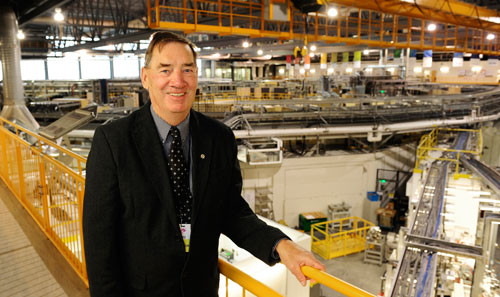U of S researchers honoured at SHRF Santé! Awards Evening
Five U of S researchers were honoured at the Saskatchewan Health Research Foundation’s annual Santé! Awards evening in Saskatoon on December 1 for their work to advance synchrotron science, breast cancer research, hepatitis C treatment, and to help improve treatments for joints damaged by age and illness.
By Kris Foster Professor emeritus Dennis Johnson received the SHRF Achievement Award for his long career dedicated to health research in Saskatchewan. Johnson helped establish some of the province's primary research facilities, such as the Cameco MS Neuroscience Research Centre, the Saskatchewan Drug Research Institute and the Canadian Light Source. In 2004, Johnson became director of the Saskatchewan Synchrotron Institute which provided $1 million in funding to train researchers. Synchrotron-based health research has since become one of the province's key research funding priorities.
Professor emeritus Dennis Johnson received the SHRF Achievement Award for his long career dedicated to health research in Saskatchewan. Johnson helped establish some of the province's primary research facilities, such as the Cameco MS Neuroscience Research Centre, the Saskatchewan Drug Research Institute and the Canadian Light Source. In 2004, Johnson became director of the Saskatchewan Synchrotron Institute which provided $1 million in funding to train researchers. Synchrotron-based health research has since become one of the province's key research funding priorities.
Four Top Researcher Awards were given in four different categories.
The award in the New Investigator Establishment Grants – Biomedical category went to Yuliang Wu, from the department of biochemistry in the College of Medicine.
Wu aims to understand how protein changes can lead to breast cancer and Fanconi anemia, a genetic disease that often leads to leukemia and other types of cancer. Wu and his team are looking at the Fanconi anemia group J protein, which contributes to DNA repair. He has identified changes, or mutations, in the protein in cases of breast cancer or Fanconi anemia and is conducting further research to determine the potential structural defects. This knowledge is an important step toward possible therapies that target the mutated protein.
The award in the New Investigator Establishment Grants – Socio-Health, Clinical and Systems category went to Sandra Webber, from the department of physical therapy in the College of Medicine.
Webber is working to determine the benefits of using a lower body positive pressure treadmill in older patients with arthritis after total knee replacement. These specially designed treadmills, which take some of the weight off the user's feet, are used to help rehabilitate young athletes, but there have been no controlled studies on older individuals. She hopes her work will improve recovery rates and lead to new protocols to promote physical activity earlier after joint replacement and other rehabilitation applications for older adults.
The award in the Postdoctoral Research Fellowships – Biomedical category went to Sandra Schulz from the department microbiology and immunology in the College of Medicine. Schulz works with supervisor Sylvia van Drunen Littel-van den Hurk at the Vaccine and Infectious Disease Organization – International Vaccine Centre (VIDO-InterVac).
Hepatitis C virus, a major cause of chronic liver disease, is widespread among Canadian Aboriginal people, particularly in Saskatchewan. Current treatment is ineffective. Schulz is studying dendritic cells, part of the body's immune system. In particular, she wants to see if a particular enzyme known to impair immune response is modified in the dendritic cells of hepatitis C patients. What she learns could help identify inhibitors that, when used in conjunction with drug therapy or vaccination, could provide new, more reliable treatments for the disease.
The award in the Postdoctoral Research Fellowships – Socio-Health, Clinical and Systems category went to Rami Al-Nazer. Al-Nazer is working under the supervision of Joel Lanovaz from the College of Kinesiology to build a knee joint model to provide insight into strain distribution during physical activity.
The knee is the most common joint affected by osteoarthritis and is considered to be one of the leading causes of disability and discomfort among seniors. Al-Nazer's work will contribute to treatments and prevention strategies that preserve normal joint mechanics. The knee model can also be used to investigate factors that increase the risk of developing osteoarthritis and may help the clinical success of knee joint replacement design.

